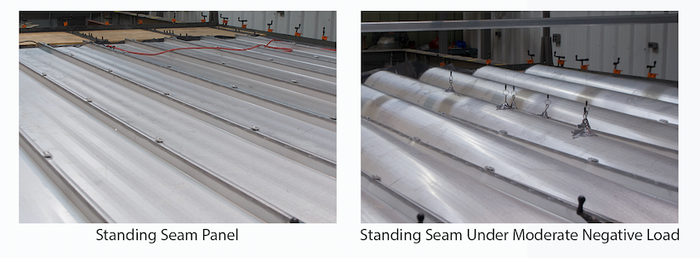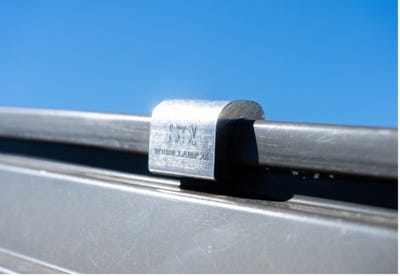Metal Roofing and Wind Uplift Resistance
Learn the distinct advantages of standing seam metal roofing over other roof types.

Metal roofing is known for its durability, long-lasting performance and reliability. The exceptional performance of metal roofing in high-wind conditions is due in part to its attachment methods and interlocking installation where roof panels are overlapped and attached to the structure of the building, reducing the ability of wind to disrupt the panels.
Standing seam metal roofing has a distinct advantage over other roof types, such as membrane and hot-applied asphaltic roofs because it serves as a “structural” covering, meaning it can be engineered to withstand almost any force imposed by wind. When so designed, some structural standing seam profiles can withstand extremely high forces, making metal the roof of choice in high-wind regions.

Design Winds Speed & Wind Forces
Wind speeds vary throughout the U.S. with high wind-prone areas found in coastal communities and some mountainous regions, and lower wind-prone areas found in much of the interior states. The design wind speed is primarily determined by the area's highest recorded three-second wind gust (measured 33’ above ground), which in turn is used to calculate the maximum overturning forces on a building and maximum uplift forces on a roof.
Wind speed (mph) has to be translated into units of force (PSF) for design purposes (in accordance with ASCE-7). The resulting forces can be different in various roof zones. A building’s size and geometry impact those forces and zones. For example, a 60-foot-tall building experiences stronger wind forces than a 30-foot-tall building, even if both are in the same area with the same design wind speed. The overall terrain and the building’s immediate surroundings also impact wind forces. Valleys, hills, slopes and cliff-sides, as well as obstacles in the wind’s path, such as nearby buildings and wooded areas, can reduce–or in some cases–increase wind speed/force. Wide-open terrain or open-water surfaces can set the stage for increases.

Wind Uplift—a Design Engineering Consideration for Any Roof
Proper roof design depends on the region’s design wind speeds and how the aforementioned factors alter the wind forces acting upon it. No matter where a building is located or what it is constructed from, there are minimum standards of forces it should withstand, including wind uplift forces on its roof. So, the roof must be strong enough to withstand the maximum uplift design forces determined for the building. As the minimum uplift forces increase in areas with higher winds, such as hurricane-prone areas, roofs must be more durable. Metal roofing lends itself to high wind-prone areas since it can easily be engineered to withstand nearly any uplift force.
Metal Roof Design & Impact on Wind Resistance
 Metal roof installation methods are relatively similar everywhere, but it is the building and the roof system design that affects resistance to wind forces. Critical design factors impacting the roof’s strength include roof panel design and thickness, the clips attaching the roof to the underlying structure and the underlying structure (rafters and purlins). There is a myriad of choices for roof panels, all with various strength characteristics.
Metal roof installation methods are relatively similar everywhere, but it is the building and the roof system design that affects resistance to wind forces. Critical design factors impacting the roof’s strength include roof panel design and thickness, the clips attaching the roof to the underlying structure and the underlying structure (rafters and purlins). There is a myriad of choices for roof panels, all with various strength characteristics.
Some standing seam roofs and clips are designed specifically for tremendous uplift performance. Features can be manufactured into the roof, such as rib shape and increased metal thickness that control the roof stiffness and strength. Additionally, the appropriate clip must be used to meet the wind uplift requirements for each building―not all clips are the same. Various materials, material gauge, length and points of attachment all affect the performance of the clip. For example, one might use a 26ga clip to obtain a specific wind rating, while one might use a 22ga clip to increase the performance―should the failure mode be the strength of the clip.
Using more material to increase wind uplift performance can be done either by increasing material thickness or just using more material in general―either in the clip (more folds, longer length), the seam (more folds) and/or decrease clip spacing (more clips). Installing additional clips (attachment points between the roof and structure) increases the roof’s wind resistance. The number of purlins installed on a building impacts the overall strength of the roof and controls the allowable attachment points.
Finally, new or existing uplift performance can be significantly increased with the use of externally applied seam clamps for a comparatively low cost. Placed over the roof’s seams at designated intervals, external seam clamps increase the roof’s wind resistance capacity, preventing multiple modes of failure, including seam separation and clip disengagement when used at roof clip locations.
Testing Standards for Wind Resistance
Metal roofing is designed for buildings throughout the country and around the world, with varying resistance to wind forces. So, materials, products and designs are tested for all wind pressures in those markets to demonstrate their strength. Thus, various resistances to wind force can be attained through testing specific roof system assemblies.
UL 580: Tests for Uplift Resistance of Roof Assemblies is one of these test standards. The uplift resistance of a roof assembly is listed as Class 15, 30, 60 or 90. The spectrum of 15-90 is comparative ratings, which are not related to specific wind speeds. For example, Class 90 involves 56.5 psf vacuum pressure and 48.5 psf upward pressure from below on a 10’ x 10’ specimen anchored at its perimeter.
Another test standard, FM-4471: Approval Standard for Class 1 Panel Roofs/Roof Assemblies lists roofs to Class 1-60, 90, 120, 150 & 180. The nomenclatures 60-180, in the FM standard, relate to static pressure―also not wind speed but a larger specimen.
The most notable test standard is ASTM E1592: Standard Test Method for Structural Performance of Sheet Metal Roof and Siding Systems by Uniform Static Air Pressure Difference. It is somewhat different than other test standards whereby sample roof assemblies are subject to increasing loads until failure. The maximum load obtained is published as an ultimate load, and a design load is determined from the appropriate safety factor, which is then used to select a system for wind pressures.
With appropriate design and testing, metal roofing affords greater durability than other roof types and is particularly critical for use in high-wind areas. According to Monroe County, Florida’s staff summary post-Hurricane Irma inspections found that “metal roofs fared far better than those roofs covered by asphalt shingles” and in recent years, county officials even proposed an ordinance to require all new or replacement roofs to be metal. That’s a true testament to the sustainability and durability of metal roofing, particularly in high wind prone areas.
Editor's note: For information, videos and webinars on this topic please visit www.s-5.com and learn more about the key factors to increasing wind uplift performance on your metal roof. All photos courtesy of S-5!.
About the Author(s)
You May Also Like




